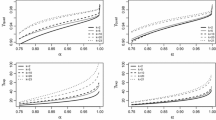Abstract
Expected utility theory is nowadays accepted as the standard for rational choice among risky assets. However, as Harry Markowitz recently pointed out, the problem of how the maximum expected utility along the risk–return portfolio efficient frontiers approximates the exact maximum expected utility is still open. This paper shows that some popular risk–return models are actually able to approximate expected utility maximization with respect to classical and new distance measures. It also analyzes the ability of the whole risk–return efficient frontiers to approximate the exact one. Our empirical analysis is based on recent publicly available real-world data sets.







Similar content being viewed by others
References
Acerbi, C., Tasche, D.: On the coherence of expected shortfall. J. Bank. Finance 26(7), 1487–1503 (2002)
Allais, M.: The foundations of the theory of utility and risk some central points of the discussions at the oslo conference. In: Progress in Utility and Risk Theory. Springer, pp 3–131 (1984)
Bruni, R., Cesarone, F., Scozzari, A., Tardella, F.: A linear risk-return model for enhanced indexation in portfolio optimization. OR Spectr. 37(3), 735–759 (2015)
Bruni, R., Cesarone, F., Scozzari, A., Tardella, F.: On exact and approximate stochastic dominance strategies for portfolio selection. Eur. J. Oper. Res. 259(1), 322–329 (2017)
Cesarone, F., Scozzari, A., Tardella, F.: A new method for mean-variance portfolio optimization with cardinality constraints. Ann. Oper. Res. 205(1), 213–234 (2013)
Cesarone, F., Scozzari, A., Tardella, F.: Linear vs. quadratic portfolio selection models with hard real-world constraints. Comput. Manag. Sci. 12(3), 345–370 (2015)
Cesarone, F., Moretti, J., Tardella, F.: Optimally chosen small portfolios are better than large ones. Econ. Bull. 36(4), 1876–1891 (2016)
Fábián, C.I., Mitra, G., Roman, D.: Processing second-order stochastic dominance models using cutting-plane representations. Math. Program. 130(1), 33–57 (2011)
Gurobi Optimization I: Gurobi optimizer reference manual. http://www.gurobi.com (2015)
Hlawitschka, W.: The empirical nature of taylor-series approximations to expected utility. Am. Econ. Rev. 84(3), 713–719 (1994)
Jensen, J.L.W.V.: Sur les fonctions convexes et les inégalités entre les valeurs moyennes. Acta Math. 30(1), 175–193 (1906)
Kondor, I., Pafka, S., Nagy, G.: Noise sensitivity of portfolio selection under various risk measures. J. Bank. Finance 31(5), 1545–1573 (2007)
Konno, H., Yamazaki, H.: Mean-absolute deviation portfolio optimization model and its applications to tokyo stock market. Manag. Sci. 37(5), 519–531 (1991)
Kopa, M., Post, T.: A general test for ssd portfolio efficiency. OR Spectr. 37(3), 703–734 (2015)
Kroll, Y., Levy, H., Markowitz, H.M.: Mean-variance versus direct utility maximization. J. Finance 39(1), 47–61 (1984)
Levy, H.: Stochastic dominance and expected utility: survey and analysis. Manag. Sci. 38(4), 555–593 (1992)
Levy, H., Markowitz, H.M.: Approximating expected utility by a function of mean and variance. Am. Econ. Rev. 69(3), 308–317 (1979)
Lizyayev, A.: Stochastic dominance efficiency analysis of diversified portfolios: classification, comparison and refinements. Ann. Oper. Res. 196(1), 391–410 (2012)
Mansini, R., Ogryczak, W., Speranza, M.G.: Conditional value at risk and related linear programming models for portfolio optimization. Ann. Oper. Res 152(1), 227–256 (2007)
Markowitz, H.M.: Portfolio selection. J. Finance 7(1), 77–91 (1952)
Markowitz, H.M.: Portfolio Selection: Efficient Diversification of Investments. Cowles Foundation for Research in Economics at Yale University, Monograph 16. Wiley, New York (1959)
Markowitz, H.M.: Mean-variance approximations to the geometric mean. Ann. Financ. Econ. 7(1), 1–30 (2012)
Markowitz, H.M.: The “Great Confusion” concerning MPT. Aestimatio J Finance 4, 8–27 (2012)
Markowitz, H.M.: Which risk-measure best represents return distributions with large deviations? Int. J. Portf. Anal. Manag. 1(2), 93–111 (2012)
Markowitz, H.M.: Mean-variance approximations to expected utility. Eur. J. Oper. Res. 234(2), 346–355 (2014)
Markowitz, H.M., Blay, K.: Risk-Return Analysis: The Theory and Practice of Rational Investing, vol. 1. McGraw Hill Professional, Nee York (2013)
Meucci, A.: Risk and Asset Allocation. Springer, New York (2009)
Ogryczak, W., Ruszczyński, A.: From stochastic dominance to mean-risk models: semideviations as risk measures. Eur. J. Oper. Res. 116(1), 33–50 (1999)
Ogryczak, W., Ruszczynski, A.: Dual stochastic dominance and related mean-risk models. SIAM J. Optim. 13(1), 60–78 (2002)
Pulley, L.B.: A general mean-variance approximation to expected utility for short holding periods. J. Financ. Quant. Anal. 16(03), 361–373 (1981)
Rockafellar, R., Uryasev, S.: Optimization of conditional value-at-risk. J. Risk 2, 21–42 (2000)
Roman, D., Mitra, G.: Portfolio selection models: a review and new directions. Wilmott J. 1(2), 69–85 (2009)
Roman, D., Darby-Dowman, K., Mitra, G.: Portfolio construction based on stochastic dominance and target return distributions. Math. Program. 108(2), 541–569 (2006)
Rubinstein, R.: Generating random vectors uniformly distributed inside and on the surface of different regions. Eur. J. Oper. Res. 10(2), 205–209 (1982)
Simaan, Y.: What is the opportunity cost of mean-variance investment strategies? Manag. Sci. 39(5), 578–587 (1993)
Speranza, M.: Linear programming models for portfolio optimization. Finance 14, 107–123 (1993)
Tobin, J.: Liquidity preference as behavior towards risk. Rev. Econ. Stud. 25(2), 65–86 (1958)
Young, M.R.: A minimax portfolio selection rule with linear programming solution. Manag. Sci. 44(5), 673–683 (1998)
Acknowledgements
The authors wish to thank Harry M Markowitz for his interest in this research and for his encouragement. Furthermore, they are grateful to Fabio Tardella for his helpful support and feedback, and to two anonymous referees for their constructive comments.
Author information
Authors and Affiliations
Corresponding author
Rights and permissions
About this article
Cite this article
Carleo, A., Cesarone, F., Gheno, A. et al. Approximating exact expected utility via portfolio efficient frontiers. Decisions Econ Finan 40, 115–143 (2017). https://doi.org/10.1007/s10203-017-0201-0
Received:
Accepted:
Published:
Issue Date:
DOI: https://doi.org/10.1007/s10203-017-0201-0




